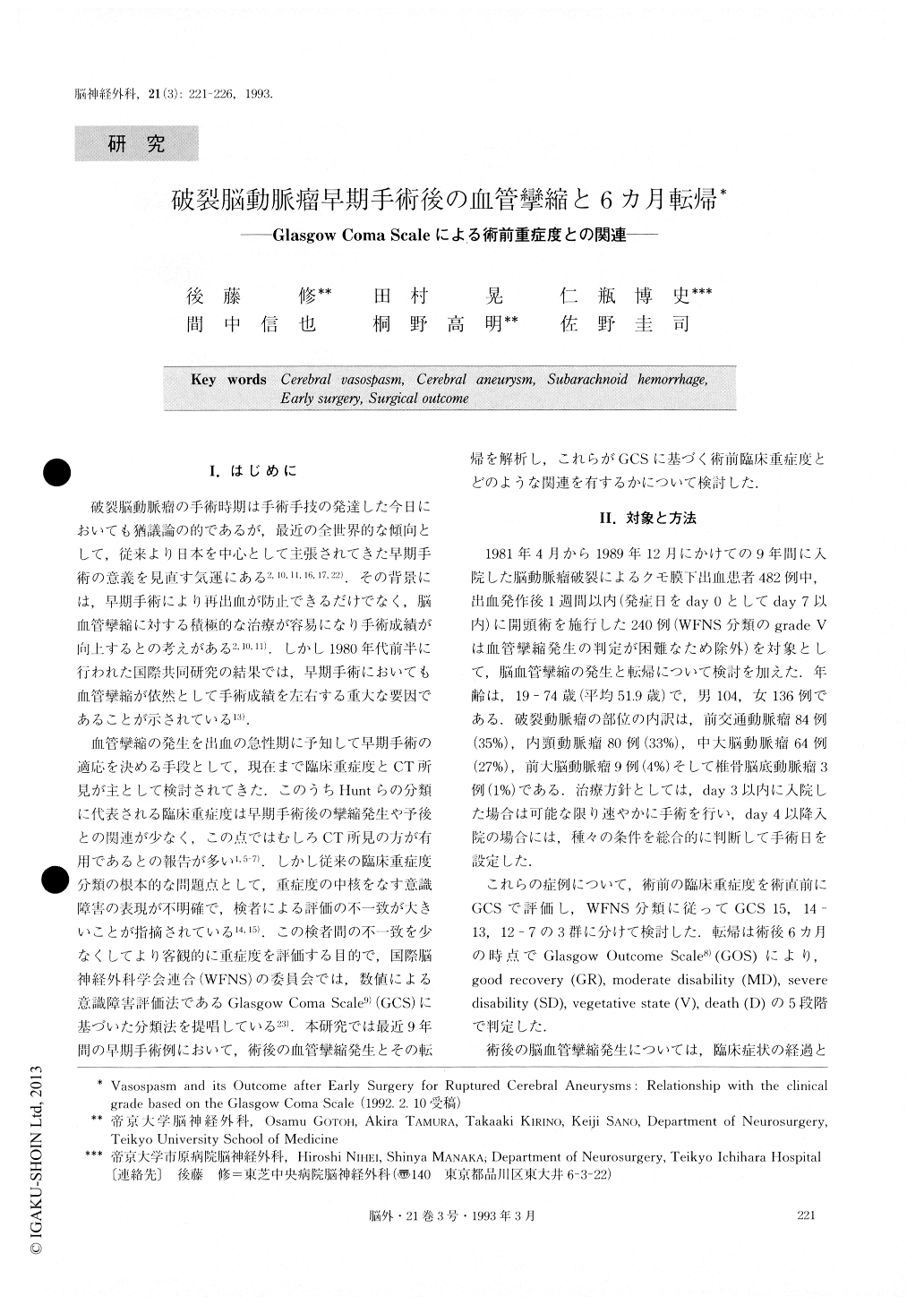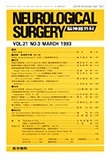Japanese
English
- 有料閲覧
- Abstract 文献概要
- 1ページ目 Look Inside
I.はじめに
破裂脳動脈瘤の手術時期は手術手技の発達した今日においても猶議論の的であるが,最近の全世界的な傾向として,従来より日本を中心として主張されてきた早期手術の意義を見直す気運にある2,10,11,16,17,22).その背景には,早期手術により再出血が防止できるだけでなく,脳血管攣縮に対する積極的な治療が容易になり手術成績が向上するとの考えがある2,10,11).しかし1980年代前半に行われた国際共同研究の結果では,早期手術においても血管攣縮が依然として手術成績を左右する重大な要因であることが示されている13).
血管攣縮の発生を出血の急性期に予知して早期手術の適応を決める手段として,現在まで臨床重症度とCT所見が主として検討されてきた.このうちHuntらの分類に代表される臨床重症度は早期手術後の攣縮発生や予後との関連が少なく,この点ではむしろCT所見の方が有用であるとの報告が多い1,5-7).しかし従来の臨床重症度分類の根本的な問題点として,重症度の中核をなす意識障害の表現が不明確で,検者による評価の不一致が大きいことが指摘されている14,15).この検者間の不一致を少なくしてより客観的に重症度を評価する目的で,国際脳神経外科学会連合(WFNS)の委員会では,数値による意識障害評価法であるGlasgow Coma Scale9)(GCS)に基づいた分類法を提唱している23).本研究では最近9年間の早期手術例において,術後の血管攣縮発生とその転帰を解析し,これらがGCSに基づく術前臨床重症度とどのような関連を有するかについて検討した.
Over a 9 year period, 270 patients who had early aneurysm surgery within 7 days after subarachnoid hemorrhage were analyzed regarding occurrence of vasospasm (VS) and its outcome. Occurrence of VS was recognized by ischemic neurological deterioration, with or without CT evidence of infarcts. Surgical outcome was assessed by the Glasgow Outcome Scale 6 months postoperatively. The results were correlated with age. aneurysm site, day of surgery, and preoperative clinical grade evaluated by the Glasgow Coma Scale (GCS).Thirty patients with the GCS sum score of less than were excluded from the analysis of VS.
Eighty two patients (34%) developed VS, of which 36 patients (15%) showed ischemic symptoms only, and 46 (19%) had infarct on CT. The incidence of symptomatic VS was 12% in GCS 15 group (117 patients), 23% in GCS 14 - 13 group (70 patients), and 11% in GCS 12 - 7 group (53 patients). That of VS with infarct was 14%, 23%, and 26% in GCS 15, GCS 14 - 13, and GCS 12 - 7 groups, re-spectively. Thus, there was a close correlation between the clinical grade based on the GCS and the incidence of VS, especially with infarct. The grade was also useful in predicting the surgical outcome. VS was more common in the older age group. The site of aneurysm or the day of surgery had no apparent influences on the incidence of VS or its outcome. Overall, the incidence of poor out-come due to VS proved to be 12%, which accounted for one-third of the cases in which there was poor outcome due to various causes.

Copyright © 1993, Igaku-Shoin Ltd. All rights reserved.


